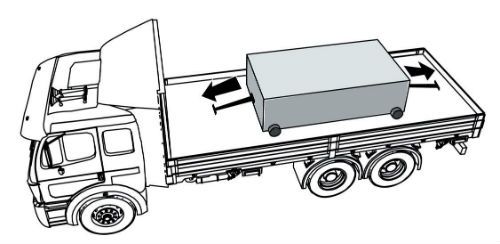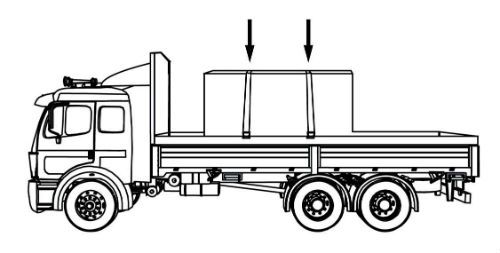CDL Practice Tests: Flatbed Cargo Securement
Choose A Section:
Go!What is the minimum WLL of a tiedown used to secure logs?
- 1,800 lb
- 4,000 lb
- It depends on if you are hauling shortwood or longwood
- 50% of cargo weight
- Use tiedowns in combination with bunks, stakes, or standards and bolsters to secure the load.
- All tiedowns must have a working load limit not less than 1,800 kg (4,000 lb.).
- Tension tiedowns as tightly as possible but not beyond their working load limit.
All of these are requirements for securing longwood lengthwise except:
- Must be cradled in two or more bunks or contained by stakes.
- Secure each log with at least two tiedowns if shorter logs are carried on top of the stack.
- Each end of the log should extend at least 3 inches beyond the stakes.
- Each outside log should bear against at least two stakes, one near each end of the log.
Requirements for securing longwood loaded lengthwise
- Longwood must be cradled in two or more bunks or contained by stakes.
- Each outside log should bear against at least two stakes, one near each end of the log.
- Each end of the log should extend at least 0.15 m (6 in) beyond the stakes.
- If shorter logs are carried on top of the stack, secure each log with at least two tiedowns.
What is a pallet used for?
- A waterproof sheet used to cover cargo.
- A platform or tray on which cargo is placed so that it can be handled as an article. (Same as "Skid")
- A vertical barrier across the front of the deck of a vehicle to prevent forward movement of cargo.
- A vertical barrier across a vehicle to prevent forward movement of cargo.
Pallet:
A platform or tray on which cargo is placed so that it can be handled as an article. (Same as "Skid")
When securing an intermodal container on a chassis, what is the maximum allowable vertical travel when secured?
- 2 inches
- 1 inch
- 2 1/2 inches
- 1/2 inch
Securing devices must restrain the container from moving more than:
- 1.27 cm (1/2 in) forward.
- 1.27 cm (1/2 in) rearward.
- 1.27 cm (1/2 in) to the right.
- 1.27 cm (1/2 in) to the left.
- 2.54 cm (1 in) vertically.
When using tiedowns for securing cargo, what is the general rule regarding cargo length.
- 1 tiedown for every 15 ft, or part thereof.
- 1 tiedown for every 5 ft, or part thereof.
- 1 tiedown for every 10 ft, or part thereof.
- 2 tiedowns for every 10 ft, or part thereof.
When cargo is prevented from forward movement (for example, by the headboard, bulkhead, other cargo, or tiedown), secure the cargo according to the following requirements:

All Cargo:
1 tiedown for every 10 ft, or part thereof.
What is the minimum nominal dimension of timber blocking used to secure concrete pipe?
- 2 x 4 in
- 8 x 10 in
- Half the diameter of the pipe
- 4 x 6 in
Blocking must be:
- Placed against the pipe
- Secured to prevent it from moving out from under the pipe.
Timber blocking must have a minimum nominal dimension of 10 x 15 cm (4 x 6 in).
When loading and securing a boulder, it should be:
- Supported on at least 2 pieces of 4in x 4in hardwood blocking, extending the full width of the boulder.
- All of these are requirements.
- Placed on symmetrical hardwood blocking that extends 3/4 of the length of the boulder.
- Placed on the vehicle with its largest or flattest side down.
Requirements

Place each boulder on the vehicle with its flattest and/or largest side down.

Support each boulder on at least two pieces of hardwood blocking (at least 10 cm x 10 cm (4 x 4 in) that extend the full width of the boulder.
Place hardwood blocking pieces as symmetrically as possible under the boulder so they support at least 3/4 of the length of the boulder.
Which of the following is not a requirement for shortwood loaded lengthwise?
- Heavier logs must be stacked on top.
- Logs should be centered in the bunk.
- Must be cradled in a bunk or contained by stakes.
- Each outside log bearing against stakes should extend at least 6 in beyond the stakes at each end.
Requirements for shortwood loaded lengthwise
- Shortwood must be cradled in a bunk or contained by stakes.
- Logs should be centered in the bunk.
- Each outside log bearing against stakes should extend at least 0.15 m (6 in) beyond the stakes at each end.
The load carrying area of a truck, trailer, or intermodal container is referred to as the:
- Deck
- Bulkhead
- Well
- Headboard
Deck:
The load carrying area of a truck, trailer, or intermodal container.
Working Load Limit (WLL)is defined as:
- The summation of the working load limits or restraining capacity of all devices used to secure an article on a vehicle.
- The maximum load that may be applied to a component of a cargo securement system during normal service, usually assigned by the manufacturer of the component.
- The number of hours that a tiedown can be used.
- The acceleration due to gravity, 9.823 m/sec2 (32.2 ft/sec2).
Working Load Limit (WLL):
The maximum load that may be applied to a component of a cargo securement system during normal service, usually assigned by the manufacturer of the component.
About The Flatbed Cargo Securement CDL Manual
Studying the flatbed cargo securement CDL manual is not a requirement for getting your CDL permit or license. It is required knowledge for flatbed drivers.
Some questions you should be able to answer for flatbed cargo securement:
- What is the minimum Working Load Limit of a tiedown used to secure logs?
- What is the minimum weight of a shipment of paper rolls that would require specific securement requirements?
- When securing concrete pipe over 45 inches loaded crosswise, which direction must the tiedowns on the front half of the load run?
- What is a cab shield?
- When securing concrete pipe over 45 inches loaded crosswise, which direction must the tiedowns on the rear half of the load run?
- What is a dunnage bag?
- Who is responsible for inspecting securing devices and cargo within the first 50 miles?
- How many tiedowns are required on a stack of shortwood loaded crosswise?
- What is the minimum working load limit of each tiedown used to secure crushed or flattened vehicles?
- Define 'bolster'
- What is a hook-lift container?
- When a tiedown is attached directly to the cargo, what is the ideal angle where it attached to the vehicle?
What is a securing device?
Any device specifically manufactured to attach or secure cargo to a vehicle or trailer:
- Synthetic Webbing
- Chain
- Wire rope
- Manila rope
- Synthetic rope
- Steel strapping
- Clamps and latches
- Blocking
- Front-end structure
- Grab hooks
- Binders
- Shackles
- Winches
- Stake pockets
- D-rings
- Webbing ratchet
- Bracing
- Friction mat
What is a tiedown?
A combination of securing devices that forms an assembly that:
- Attaches cargo to, or restrains cargo on a vehicle.
- Is attached to anchor point(s).

Some tiedowns are attached to the cargo and provide direct resistance to restrain the cargo from movement.

Some tie-downs pass over or through the cargo. They create a downward force that increases the effect of friction between the cargo and the deck. This friction restrains the cargo.
 Related Cargo Securement Terms That Every Driver Should Know:
Related Cargo Securement Terms That Every Driver Should Know:
-
Tiedown:
A combination of securing devices which form an assembly that attaches cargo to, or restrains cargo on, a vehicle or trailer, and is attached to anchor point(s).
-
Contained:
Cargo is contained if it fills a sided vehicle, and every article is in contact with or sufficiently close to a wall or other articles so that it cannot shift or tip if those other articles are also unable to shift or tip.
-
Blocking:
A structure, device, or another substantial article placed against or around an article to prevent horizontal movement of the article.
How should tiedowns be attached?
Tiedowns can be used in two ways:
-
Attached to the cargo:
- Tiedowns attached to the vehicle and attached to the cargo.
- Tiedowns attached to the vehicle, pass through or aroundan article of cargo, and then are attached to the vehicle again.
-
Pass over the cargo:
- Tiedowns attached to the vehicle, passed over the cargo, and then attached to the vehicle again.
Tiedown placement:

Place the tiedown as close as possible to the spacer.
Position the tiedowns as symetrically as possible over the length of the article.

Position the tiedowns to preserve the integrity of the article.







 TT On Facebook
TT On Facebook